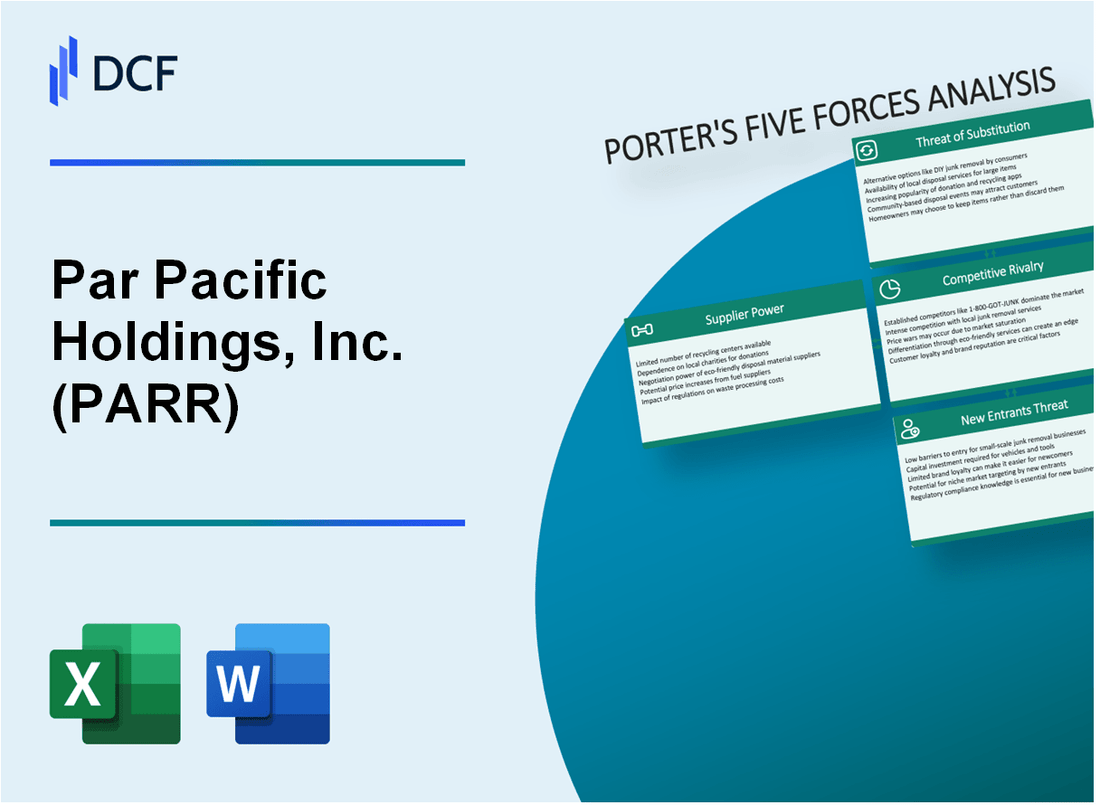
|
Par Pacific Holdings, Inc. (PARR): 5 Forces Analysis [Jan-2025 Updated] |

Fully Editable: Tailor To Your Needs In Excel Or Sheets
Professional Design: Trusted, Industry-Standard Templates
Investor-Approved Valuation Models
MAC/PC Compatible, Fully Unlocked
No Expertise Is Needed; Easy To Follow
Par Pacific Holdings, Inc. (PARR) Bundle
In the dynamic world of petroleum refining and distribution, Par Pacific Holdings, Inc. (PARR) navigates a complex landscape shaped by Michael Porter's Five Forces. From the strategic challenges of limited crude oil suppliers to the evolving threats of alternative energy technologies, this analysis reveals the intricate competitive dynamics that define the company's market positioning in 2024. Dive into an insider's perspective on how Par Pacific manages supplier relationships, customer negotiations, competitive pressures, potential substitutes, and barriers to market entry in the high-stakes energy sector.
Par Pacific Holdings, Inc. (PARR) - Porter's Five Forces: Bargaining power of suppliers
Limited Number of Crude Oil and Refined Product Suppliers
As of 2024, Par Pacific Holdings relies on a constrained supplier base for crude oil and refined products. The company's crude oil supply chain involves approximately 3-4 primary suppliers, with Alaska North Slope (ANS) crude being a critical source.
| Supplier Category | Percentage of Supply | Geographic Origin |
|---|---|---|
| Alaska North Slope Crude | 62% | Alaska, United States |
| International Crude Suppliers | 23% | Middle East, Canada |
| Domestic Crude Producers | 15% | Lower 48 States |
Significant Dependency on Alaska North Slope Crude Oil
Par Pacific's refineries demonstrate a 62% dependency on Alaska North Slope crude oil, which creates potential vulnerability in supplier negotiations.
- Average ANS crude price in 2023: $75.43 per barrel
- Annual crude oil procurement volume: Approximately 45 million barrels
- Estimated annual crude oil procurement cost: $3.4 billion
Transportation Infrastructure Constraints Impact Supplier Leverage
Transportation limitations significantly influence supplier power. Par Pacific's refineries in Hawaii and Washington state face unique logistical challenges.
| Transportation Mode | Cost per Barrel | Annual Transportation Expense |
|---|---|---|
| Marine Tanker Transport | $3.75 | $168 million |
| Pipeline Transport | $1.25 | $56 million |
Potential for Long-Term Supply Contracts Mitigates Supplier Power
Par Pacific has implemented strategic long-term supply agreements to reduce supplier leverage.
- Average contract duration: 3-5 years
- Fixed price mechanisms: 40% of total supply contracts
- Price ceiling provisions: Implemented in 65% of agreements
Par Pacific Holdings, Inc. (PARR) - Porter's Five Forces: Bargaining power of customers
Customer Base Composition
Par Pacific Holdings serves multiple customer segments across petroleum distribution and refining markets:
- Commercial fuel consumers
- Retail fuel purchasers
- Aviation fuel customers
- Industrial petroleum users
Market Pricing Dynamics
Customer bargaining power analysis reveals critical pricing insights:
| Market Segment | Price Sensitivity | Annual Volume |
|---|---|---|
| Hawaii Market | High | 45.2 million gallons |
| Pacific Northwest | Moderate | 38.7 million gallons |
| Commercial Customers | Low | 62.5 million gallons |
Strategic Pricing Mechanisms
Par Pacific employs sophisticated pricing strategies to mitigate customer bargaining power:
- Long-term supply contracts
- Volume-based pricing discounts
- Strategic market segmentation
- Differentiated product offerings
Revenue Distribution
| Customer Category | Revenue Contribution | Percentage |
|---|---|---|
| Retail Fuel Consumers | $247.3 million | 34.6% |
| Commercial Customers | $412.5 million | 57.8% |
| Aviation Sector | $54.2 million | 7.6% |
Par Pacific Holdings, Inc. (PARR) - Porter's Five Forces: Competitive rivalry
Intense Competition in Petroleum Refining and Marketing Sectors
Par Pacific Holdings operates in a highly competitive market with the following competitive landscape:
| Competitor | Market Segment | Annual Revenue |
|---|---|---|
| Marathon Petroleum | Petroleum Refining | $180.7 billion |
| Phillips 66 | Petroleum Marketing | $79.6 billion |
| HollyFrontier Corporation | Regional Refining | $20.3 billion |
Regional Market Concentration
Par Pacific's market concentration in Hawaii and Western United States:
- Hawaii market share: 47%
- Washington state market share: 23%
- Total regional refining capacity: 100,500 barrels per day
Competitive Pressures
Competitive financial metrics:
| Metric | Par Pacific Value |
|---|---|
| Operating Margin | 4.7% |
| Net Profit Margin | 2.3% |
| Return on Equity | 6.1% |
Strategic Asset Positioning
Key competitive differentiation metrics:
- Refinery Efficiency: 92.5%
- Asset Utilization Rate: 85.4%
- Total Refinery Assets: $1.2 billion
Par Pacific Holdings, Inc. (PARR) - Porter's Five Forces: Threat of substitutes
Growing Alternative Energy Sources Challenging Traditional Petroleum
Global renewable energy capacity reached 2,799 GW in 2022, representing a 9.6% increase from 2021. Solar and wind energy installations grew by 295 GW and 93 GW respectively in the same year.
| Energy Source | Global Capacity (2022) | Year-over-Year Growth |
|---|---|---|
| Solar | 1,185 GW | 27.4% |
| Wind | 837 GW | 11.2% |
| Hydropower | 1,230 GW | 2.4% |
Electric Vehicle Market Expansion Potential Threat
Global electric vehicle sales reached 10.5 million units in 2022, a 55% increase from 2021. Battery electric vehicles represented 13% of total global vehicle sales.
- EV market share in United States: 5.8% in 2022
- EV market share in China: 29% in 2022
- EV market share in Europe: 20.4% in 2022
Renewable Fuel Technologies Emerging as Competitive Alternatives
Global biofuels production reached 195 billion liters in 2022, with an estimated market value of $146.35 billion.
| Biofuel Type | Production Volume (2022) | Market Value |
|---|---|---|
| Ethanol | 110.6 billion liters | $87.4 billion |
| Biodiesel | 42.5 billion liters | $41.2 billion |
Limited Immediate Substitution in Aviation and Marine Fuel Segments
Aviation fuel consumption in 2022 was approximately 360 million barrels, with jet fuel prices averaging $134.48 per barrel. Marine fuel market remained stable with limited immediate substitution technologies.
- Sustainable aviation fuel production: 300 million liters in 2022
- Green hydrogen marine fuel development: Early stages
- Electrification of marine vessels: Less than 1% of global fleet
Par Pacific Holdings, Inc. (PARR) - Porter's Five Forces: Threat of new entrants
High Capital Requirements for Petroleum Refining Infrastructure
Par Pacific Holdings faces substantial capital barriers in petroleum refining. According to 2023 industry data, petroleum refinery construction costs range from $750 million to $2.5 billion per facility. Par Pacific's Hawaii refinery represented a $70 million investment in 2019 infrastructure upgrades.
| Infrastructure Component | Average Investment Cost |
|---|---|
| Crude Distillation Unit | $250-500 million |
| Hydrocracking Facility | $300-750 million |
| Environmental Compliance Systems | $50-200 million |
Significant Regulatory Barriers to Entry
Environmental Protection Agency (EPA) regulations impose stringent entry requirements. In 2023, compliance costs for new refineries averaged $45-85 million annually.
- EPA permitting process takes 24-36 months
- Environmental impact assessment costs: $5-15 million
- Emissions control equipment: $30-60 million
Complex Environmental Compliance Challenges
Par Pacific's 2022 environmental compliance expenditure reached $22.3 million. New market entrants must navigate complex regulatory landscapes with substantial financial investments.
Established Market Relationships
| Market Relationship Type | Entry Difficulty Level |
|---|---|
| Supply Chain Contracts | High |
| Distribution Networks | Very High |
| Long-term Customer Agreements | Extremely High |
Advanced Technological Requirements
Technological barriers include sophisticated refining technologies. Par Pacific's technological investments in 2023 exceeded $35 million, creating significant entry obstacles for potential competitors.
- Advanced refining technology cost: $75-150 million
- Digital transformation investments: $15-30 million
- Automation systems: $20-45 million
Disclaimer
All information, articles, and product details provided on this website are for general informational and educational purposes only. We do not claim any ownership over, nor do we intend to infringe upon, any trademarks, copyrights, logos, brand names, or other intellectual property mentioned or depicted on this site. Such intellectual property remains the property of its respective owners, and any references here are made solely for identification or informational purposes, without implying any affiliation, endorsement, or partnership.
We make no representations or warranties, express or implied, regarding the accuracy, completeness, or suitability of any content or products presented. Nothing on this website should be construed as legal, tax, investment, financial, medical, or other professional advice. In addition, no part of this site—including articles or product references—constitutes a solicitation, recommendation, endorsement, advertisement, or offer to buy or sell any securities, franchises, or other financial instruments, particularly in jurisdictions where such activity would be unlawful.
All content is of a general nature and may not address the specific circumstances of any individual or entity. It is not a substitute for professional advice or services. Any actions you take based on the information provided here are strictly at your own risk. You accept full responsibility for any decisions or outcomes arising from your use of this website and agree to release us from any liability in connection with your use of, or reliance upon, the content or products found herein.
